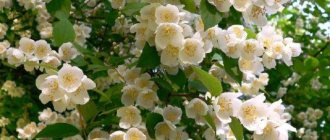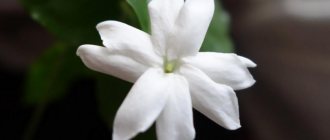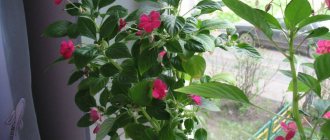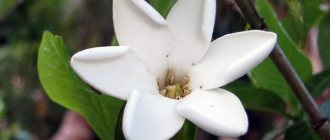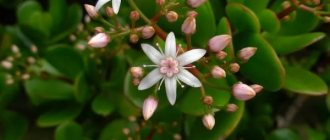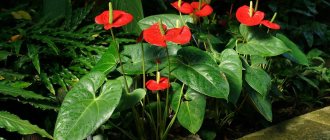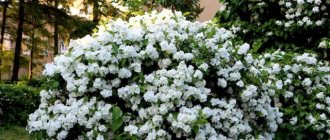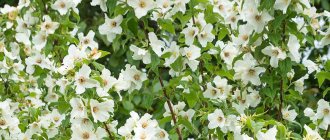What year does jasmine bloom and how long does the flowering period last?
Before you worry about how the plant is doing, you need to know what year after planting jasmine blooms. Depending on the variety, you will have to wait from 2 to 4 years.
Jasmine is easy to care for, but to see the splendor of its inflorescences, you will have to make some effort
Differences in the flowering of garden and indoor jasmine
The difference between jasmine that grows in the garden and one that is in a pot in the house is the timing of the release of buds. The plant stays dormant indoors during the winter. The first buds appear around March-April and last until early autumn.
For most outdoor varieties, the active period begins in June and lasts until the first night frosts.
Additional Information! The winter type of jasmine blooms in January-April. Jasmine sambac with white double petals or polyanthus, when creating comfortable conditions, will delight with beautiful and lush inflorescences throughout the year.
Types of jasmine with photos and names
Jasmine beesianum (Jasminum beesianum)
In nature, this species can be found along river banks, and also in the Western Chinese mountains at an altitude of up to 2500 m above sea level. It is represented by vines, shrubs or evergreens. This jasmine can reach about 200 cm in length. There are longitudinal grooves on the surface of the shoots. Simple opposite leaf blades of dark green color are pointed at the apex and have an ovoid or lanceolate shape. They are about 50 mm long, and there is slight pubescence on both surfaces of the plate. Flowering occurs in May. The fragrant flowers reach 13–17 mm in diameter and can be colored pink or dark pink. Flowers grow in the upper part of the shoot and can be either single or collected in bunches of 2 or 3 pieces.
Jasmine (Jasminum nudiflorum)
This species is represented by weakly branching shrubs. There is a small amount of foliage on long drooping shoots. Not very large trifoliate leaf plates have a rich green color. In winter, some of the leaves fall off the bush. This species is also called “winter jasmine”, this is due to the fact that its flowering begins in the middle of the winter period, and the bush fades in the middle of spring. Large flowers grow along the entire stem from the leaf axils, their color is similar to the color of an egg yolk.
Grandiflorum jasmine (Jasminum grandiflorum)
Such shrubs, vines and evergreens have bare stems that can reach 10 meters in length. The color of the opposite leaf blades is variegated. No more than seven elliptical leaves grow on the plate, which have a pointed tip, their length is no more than 30 mm. Umbrellas are placed on the tops of the stems and consist of no more than 10 large fragrant white flowers. This species blooms from June to October. The flowers of this plant are added to tea for scent.
Jasmine (Jasminum officinale)
The species is represented by perennial shrubs. Thin, smooth, long, angular branches are decorated with two- or three-pair leaf blades. The front surface of the foliage is rich green, and the back surface is pale green. The shape of the smooth leaf blades is elongated-lanceolate with a pointed tip, their edge is pubescent. Flowering occurs in April. Fragrant white flowers with long pedicels are collected in umbrella-shaped inflorescences.
Multifloral jasmine (Jasminum polyanthum)
The height of such a weakly branching shrub is about 200 cm. Its stems are curly. The oval dark green leaf blades have a wavy edge and a pointed tip. A large number of flowers grow in the upper part of the stems. They are collected in bunches of 3-5 pieces, the flowers themselves are narrow-tubular with a bend of 5 blades. The color of the buds is pink. The flowers of this species have the most pungent odor.
Low jasmine (Jasminum humile var. glabrum)
In nature, such a plant is found in mixed forests of the subtropical part of Western China at an altitude of 1000–2500 m above sea level. This species is represented by shrubs or evergreens. The height of a bush with bare shoots is about 200 cm. The length of the trifoliate leaves is up to 25 mm; they can contain no more than 7 ovoid or elliptical leaves. The front surface of the foliage is dark green, and the back surface is pale green. Umbrella-shaped inflorescences consist of several fragrant flowers. The yellow corolla of the flower reaches about 10 mm in diameter, as does the corolla tube. This species blooms in the summer.
Turned jasmine (Jasminum humile var. revolutum)
The shape of the leaf blades is ovoid, they grow in 5–7 pieces, and their length is about 60 mm. Multi-flowered inflorescences consist of flowers reaching about 25 mm in diameter, while the length of their tube is also up to 25 mm.
Jasmine sambac (Jasminum sambac), or Arabian jasmine
The homeland of this species is the tropical regions of Asia. It is represented by vines and evergreens. On the surface of the bushes, consisting of thin shoots, there is pubescence, represented by thin hairs. The length of the shoots is about 6 meters. The leaf plates are placed oppositely in 2 or 3 pieces, their length is about 100 mm, and their shape is ovoid. Most often, the leaves are rounded at the base, while their tip is pointed or blunt, and their surface may be slightly pubescent or bare. Umbrella-shaped inflorescences consist of several semi-double or double white flowers, which have a pleasant smell. The bush blooms in early spring and fades in mid-autumn. Flowers are added to tea for scent.
Jasmine (Jasminum gracillimum)
Or multi-flowered jasmine (Jasminum multiflorum). It is found naturally in the mountainous regions of the northern part of the island of Kalimantan. The species is represented by vines, shrubs or evergreens. There is pubescence on the surface of thin shoots. The simple opposite oval-lanceolate leaf blades are about 35 mm long. The plates at the base are heart-shaped and have a pointed tip; their underside is pubescent. Fragrant large flowers are painted white. This jasmine blooms in January–March.
Reasons for the lack of flowering in garden and indoor jasmine
Why hydrangea does not bloom - what to do if a garden flower produces only foliage
Knowing how many years it takes for jasmine to bloom, some gardeners note that time passes, but the buds never appear. In such a situation, you need to reconsider the care of the plant.
Lush leaves and lack of buds are a common problem.
Stagnation of moisture or lack of it
The plant loves moderate watering. Its excess leads to rotting of the roots, which is why the bush gradually fades.
When placing a shrub on a site, you need to choose the right place for it. It is prohibited to place the plant in places where groundwater passes close to the ground and in lowlands where water accumulates. Watering rules:
- regular and abundant;
- It is forbidden to use cold water and from the tap;
- watering is carried out with filtered or purified, settled water;
- It is recommended to add a few drops of acetic or citric acid to the water to acidify the liquid;
- if jasmine grows in a pot, the container should have drainage and holes in the bottom to allow residual water to escape.
Additional Information! The top layer of soil should dry out between waterings. Stagnation of water is also detrimental to home jasmine.
Insufficiently acidic soil
Jasmine should only be planted in acidic soil. If the soil is alkaline, jasmine buds will never appear.
Diseases and pests
One of the factors why garden jasmine does not bloom is its damage by insect pests or diseases. Pests:
- Aphids are large, green, and settle on the tops.
- The weevil settles in the soil near the plant and feeds on the sap of leaf blades.
- Spider mite - leaves are dotted with numerous dots, cobwebs are visible.
Diseases are indicated by yellowed or curled leaves, wilting of the entire bush, lack of growth, and falling leaves.
Diseases of the plant often lead to a slowdown in its development
Errors when applying fertilizers
The plant stops producing buds if it receives large quantities of nitrogen fertilizers. They promote the active growth of shoots and leaves, which is why the bush does not have the strength to form inflorescences. Recommended feeding mixture:
- urea 15 g;
- superphosphate 30 g;
- potassium sulfate 15 g;
- water 10 l.
Fertilizers must be alternated using mineral and organic substances.
Inappropriate lighting
If indoor jasmine does not bloom, what should I do? First of all, you need to check where the flowerpot is placed. Despite the fact that this plant is a light-loving plant, the lighting should be plentiful, but diffused, without direct sunlight. The sun causes the leaves to burn and fall off.
Additional Information! It is recommended to place the jasmine pot on the windowsills on the west or east side. On the north side it will not have enough lighting.
Temperature changes
Low temperatures at night and high temperatures during the day have a detrimental effect on the plant. It is easiest to eliminate this factor for jasmine that grows indoors. The optimal temperature is from +18 to +22.
No trimming
If the shoots are not trimmed in a timely manner, the bush will spend all its energy on their growth. Jasmine should be no more than 2 m long. If the height is 3 m or more, there will be no buds. Pruning should be regular, following a number of recommendations:
- Autumn - carried out after all the buds have withered. You need to trim off all dried inflorescences, bad and weak shoots. The cut areas should be treated with garden decoction.
- Spring – until early April. Those shoots that did not survive the winter well, old branches, and leaves left over from last year must be removed.
- Rejuvenating – carried out every 3 years. Old branches are completely cut off.
After pruning, the bush should be watered abundantly.
One of the mandatory measures is regular pruning.
Plant age
A bush that is too young and under 3 years old will not produce buds. All his strength goes into growth and strengthening.
Several reasons why mock orange does not bloom
There are few reasons for the lack of buds in garden jasmine. And before taking actions to restore flowering, you need to understand them in detail. After all, the shrub is unpretentious in care and calmly tolerates external negative factors.
Poor quality planting material
A healthy seedling is the key to full development and future flowering. It is advisable to buy planting material in specialized stores, and not in spontaneous markets. It is worth consulting with the seller about varieties that are suitable for a particular planting region.
The young plant should not have visible spots, signs of disease, dry sprouts or yellow foliage. As a rule, seedlings are available for sale in a container. The soil in such a container should be clean, without traces of mold. Otherwise, the garden crop may be damaged by infectious diseases.
Important! Saplings with an open root system are purchased shortly before planting.
Violation of landing rules
Another reason for failure to bloom is an incorrectly selected planting site. If the mock orange is in the shade, then it should be moved to a sunny area. The shrub is light-loving; if there is insufficient lighting, the shoots are pulled out and buds are not formed.
The absence of mock orange flowering can occur due to improper planting. If the seedling is too deep, the root collar becomes warm. The plant does not develop fully.
For garden jasmine, the composition of the soil matters. The land in which the bush is planted must be fertilized. If this moment is missed, it is recommended to transplant the mock orange into a fertile soil layer. Preference is given to moist, loose soil.
Violation of cultivation rules
In areas where the soil does not dry out completely, there is no place for mock orange. Or you should take care of drainage. A layer of gravel, pebbles, crushed stone 10-15 cm thick saves the situation. Lack of moisture will cause leaves to wilt and lose turgor. Without water, mock orange will not bloom, it will simply dry out.
A lack of nutrients in the soil negatively affects the flowering of mock orange. After three years, the shrub needs full nutrition with mineral fertilizers. Responds well to organic fertilizers in early summer.
Another reason why mock orange does not bloom is poor wintering. If the winter was harsh and the plant was not covered, then the annual shoots will freeze.
Attention! The plant may not bloom due to age: specimens grown from seeds bloom for 7-8 years, from cuttings - for 4-5 years.
Pests and diseases are another reason why the common mock orange does not bloom.
It is often found that garden jasmine does not reach the budding stage. This happens due to attacks by harmful insects: aphids, weevils, spider mites. Fortunately, you can get rid of them with the help of insecticides. Processing is carried out in the autumn and spring seasons. For mock orange, it is recommended to use the drug “Karbofos”. Apply the chemical according to the instructions.
In addition to insects, the condition of the bush is affected by fungal diseases: gray rot, septoria spot. Systemic fungicides will help eliminate negative symptoms.
Other Possible Flowering Problems
In addition to the lack of buds, the gardener may encounter such phenomena as their too small size or their premature shedding.
Shedding of buds
How to propagate garden jasmine in spring and summer
Jasmine can drop buds prematurely under the influence of the following factors:
- Draft or strong wind.
- Use for cold water irrigation.
- Untimely and incorrect transplantation, when the plant has already begun to produce buds.
- Dry soil, lack of nutrients and minerals.
- Incorrectly selected fertilizer or its use in excessive quantities, which causes the roots to burn.
- Lack of lighting.
Jasmine may drop its buds because the room is too hot or exposed to direct sunlight.
Additional Information! It is recommended to plant jasmine outdoors in partial shade or in a place where the lighting is good but diffuse. It is especially necessary to follow this recommendation when planting a plant in the Moscow region, where summers can be very hot.
Small flowers
Varieties of mock orange with large inflorescences include:
- Mont Blanc;
- Pyramid;
- Schneeshturm;
- Zoya Kosmodemyanskaya;
- Virgin;
- Coronary.
Owners of jasmine with large inflorescences may encounter a problem such as insufficient bud size. This is due to improper care of the plant:
- frequent drying out of the soil;
- absence or insufficient pruning, due to which the plant puts all its energy into the growth of new shoots;
- insufficient refills or their incorrect choice;
- unfavorable location of the plant in the country - the influence of a draft or strong wind, stagnation of moisture.
Establishing care will help normalize the condition. If the plant is in a draft or exposed to direct sunlight, replanting will be required.
Attention! Transplantation is prohibited during the period when jasmine is actively putting out new buds.
Jasmine propagation
There are many ways to propagate garden jasmine, the most common methods include:
- propagation by lignified cuttings;
- propagation by green cuttings
- propagation by dividing the bush;
- propagation by layering - green and root;
- propagation by seeds.
Propagation by lignified cuttings
Lignified cuttings are harvested in the fall, and annual shoots are cut out. You can use branches that are cut when clearing the bush. In spring they are planted tilted so that there are 2-3 buds on the surface. It is necessary to constantly maintain optimal environmental humidity. In the fall, the root system will form.
Propagation by green cuttings
Propagation by green cuttings can be carried out both in spring and summer. To do this, you need to cut cuttings with 2-3 buds, cut off half of the leaf blade for better rooting. Leaves cannot be completely removed to allow photosynthesis to take place. The lower cut should be oblique for better engraftment, and the upper cut should be made above the kidney. Prepared cuttings should be planted in a mixture of peat and sand in a greenhouse or greenhouse. For better rooting, you can use Kornevin, Heteroauxin or other preparations containing auxin. The greenhouse requires periodic watering. In hot weather, you need to increase the frequency of watering, spraying every 1-2 hours so that the cuttings do not burn. In this case, the temperature should not be higher than 20 degrees.
Propagation by seeds
Today, few people propagate garden jasmine from seeds, but it is still possible. To do this, you need to wait for the bush to bloom, the ovaries to form, and collect the seeds when the capsules ripen. In the second year (spring), you need to sow the seeds in a greenhouse, before thoroughly moistening it in water and mixing the swollen seeds with sand. After germination, the seedlings are thinned out and watered regularly, while weeds are destroyed and the soil is loosened. In the second year of jasmine’s life, it is radically pruned: cutting off the above-ground part almost completely for better tillering, due to which young plants form several strong shoots. The resulting high-quality seedlings of garden jasmine can be planted in a permanent place in your garden in the fall or put up for sale.
What to do if jasmine does not bloom on your property or at home
Indoor jasmine - how to care
The absence of buds in a plant over 3 years old is a signal to the gardener that he is not caring for it correctly. To restore the condition of jasmine, it is necessary to carry out a number of measures to eliminate negative factors:
- normalize watering - it should be frequent, but without overwatering;
- change, if necessary, the location - diffused light or partial shade is needed;
- change fertilizers. If only nitrogen substances were introduced, it is necessary to alternately use mineral and organic feeds;
- normalize cropping. It should be regular, held in autumn and spring.
If the jasmine is on the street and all measures to resuscitate it have been in vain, it needs to be transplanted. Perhaps it's all about the soil being poor in nutrients and minerals.
Jasmine will thank you for comfort with delicate, beautiful petals.
Briefly about cultivation
- Flowering: about three weeks, flowering time depends on the type of plant.
- Lighting: bright but diffused light.
- Temperature: during the period of active growth – 18-24 ºC, in winter – about 10 ºC.
- Watering: from spring to autumn - moderate, as soon as the top layer of the substrate dries, in the fall watering is gradually reduced, and in winter it is watered only so that the earthen ball does not dry out completely.
- Humidity: high. Before and after flowering, spraying with water at room temperature is recommended, and during flowering the pot with the plant is kept on a tray with wet expanded clay. During the dormant period, spraying is not carried out.
- Fertilizing: during the growing season twice a month with mineral and organic fertilizers alternately. In autumn, fertilizing is done once a month, and in winter, jasmine is not fed.
- Dormant period: from late autumn to spring.
- Transplantation: in spring, young plants - annually, adults - once every 2-3 years.
- Substrate: 1 part sand and 2 parts each of leaf, coniferous and peat soil.
- Reproduction: by cuttings.
- Pests: aphids, spider mites, scale insects, mealybugs and whiteflies.
- Diseases: rot and loss of leaves due to improper care and maintenance.
- Properties: In folk medicine, the plant is a medicinal plant, but the strong aroma of jasmine can cause headaches.
Read more about growing jasmine below.
How to care for jasmine after the flowering period
During the dormant period, caring for jasmine includes:
- reducing the frequency and amount of fertilizers applied using organic matter;
- reducing watering, but without prolonged drying out of the soil;
- pruning;
- preparation for wintering.
Pruning at the end of the active period involves removing faded buds and bad, weakest shoots.
Most varieties of jasmine are frost-resistant. But in regions with severe frosts, it is necessary to build a shelter for the plant, covering it with spruce branches or agrofibre. Young shoots under 4 years of age especially need shelter.
Jasmine is a beautiful plant, with a variety of colors of delicate petals, for which it is so loved. But it happens that it cannot bloom and the reason for this is improper care. To normalize the condition of the plant, it is necessary to create comfortable conditions for it outdoors or in a pot.
The healing properties of jasmine
Jasmine foliage is used to stop lactation, and it can also reduce body temperature. This plant is used to make hot compresses that can be applied to skin ulcers. The raw root of this flower is used as a pain reliever for fractures, and it can also help with headaches and insomnia. Young leaves are used in preparing salads as a seasoning.
